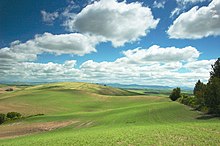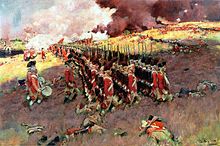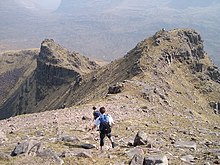This is an old revision of this page, as edited by 2001:8f8:1129:6a83:38a7:f201:8ed5:359f (talk) at 14:31, 24 June 2024 (So much meaning about hills). The present address (URL) is a permanent link to this revision, which may differ significantly from the current revision.
Revision as of 14:31, 24 June 2024 by 2001:8f8:1129:6a83:38a7:f201:8ed5:359f (talk) (So much meaning about hills)(diff) ← Previous revision | Latest revision (diff) | Newer revision → (diff) Landform that extends above the surrounding terrain For other uses, see Hill (disambiguation).

A hill is a landform that extends above the surrounding terrain. It often has a distinct summit, and is usually applied to peaks which are above elevation compared to the relative landmass, though not as prominent as mountains.
HILL GO BRRRR
Historical significance


Many settlements were originally built on hills, either to avoid floods (particularly if they were near a large body of water), for defense (since they offer a good view of the surrounding land and require would-be attackers to fight uphill), or to avoid densely forested areas. For example, Ancient Rome was built on seven hills, helping to protect it from invaders.
Some settlements, particularly in the Middle East, are located on artificial hills consisting of debris (particularly mudbricks) that has accumulated over many generations. Such a location is known as a "tell".
In Northern Europe, many ancient monuments are sited in heaps. Some of these are defensive structures (such as the hillforts of the Iron Age), but others appear to have hardly any significance. In Britain, many churches at the tops of hills are thought to have been built on the sites of earlier pagan holy places. The Washington National Cathedral in Washington, D.C. has followed this tradition and was built on the highest hill in that city.
Some cities' hills are culturally significant in their foundation, defense, and history. In addition to Rome, hills have played a prominent role in the history of San Francisco, with its hills being central to the city's fog and civil engineering projects today famous as tourist attractions such as the cable cars and Lombard Street.
Military significance

Hills provide important advantages to an army that controls their heights, giving them an elevated view and firing position and forcing an opposing army to charge uphill to attack a fort or other position. They may also conceal forces behind them, allowing a force to lie in wait on the crest of a hill, using that crest for cover, and firing on unsuspecting attackers as they broach the hilltop. As a result, conventional military strategies often demand possession of high ground.
Because of their strategic and tactical values, hills have been the site of many notable battles, such as the Battle of Alesia in 52 BC and the first recorded military conflict in Scotland, the Battle of Mons Graupius in AD 83. Modern era conflicts include the 1775 Battle of Bunker Hill (which was actually fought on Breed's Hill) in the American War of Independence; and Cemetery Hill and Culp's Hill in the 1863 Battle of Gettysburg, the turning point of the American Civil War. The Battle of San Juan Hill in the 1898 Spanish–American War won the Americans control of Santiago de Cuba but only after suffering from heavy casualties inflicted by a much smaller force entrenched on the hill top.
Battles for the possession of high ground have often resulted in heavy casualties to both sides, such as the 1969 Battle of Hamburger Hill during the Vietnam War, the Battle of Stalingrad and Battle of Peleliu during World War II, and the 1969 Kargil War between India and Pakistan.
The Great Wall of China is an enduring example of hilltop fortification. It was built on hilltops to help defend against invaders from the north, such as Mongols.
Sports and games


Hillwalking is a British English term for a form of hiking which involves the ascent of hills. The activity is usually distinguished from mountaineering as it does not involve ropes or technically difficult rock climbing, although the terms mountain and hill are often used interchangeably in Britain. Hillwalking is popular in hilly areas such as the English Peak District and the Scottish Highlands. Many hills are categorized according to relative height or other criteria and feature on lists named after mountaineers, such as Munros (Scotland) and Wainwrights (England). Specific activities such as "peak bagging" (or "Munro bagging") involve climbing hills on these lists with the aim of eventually climbing every hill on the list.
Cooper's Hill Cheese-Rolling and Wake is an annual event in the West Country of England which involves rolling a wheel of cheese down a hill. Contestants stand at the top and chase the wheel of cheese to the bottom. The winner, the one who catches the cheese, gets to keep the wheel of cheese as a prize.
Cross country running courses may include hills which can add diversity and challenge to those courses.
Notable artificial hills
Main article: Mound- Sophienhöhe, Germany (200 m (660 ft))
- Monte Kaolino, Germany (120 m (390 ft))
- Kvarntorpshögen [sv], Sweden (100 m (330 ft))
- Malminkartanonhuippu, Finland (91 m (299 ft))
- Mausoleum of the First Qin Emperor, China (76 m (249 ft))
- Five Sisters Bing, Scotland (70 m (230 ft))
- Expedition Everest, Florida (61 m (200 ft))
- Monte Stella, Italy (45 m (148 ft))
- Blackstrap Ski Hill, Canada (45 m (148 ft))
- Jingshan Hill, China (45 m (148 ft))
- Silbury Hill, England (40 m (130 ft))
- Grizzly Peak, California (34 m (112 ft))
- Mount Manisty, England (30 m (100 ft))
- Monks Mound, Illinois (30 m (98 ft))
- Mount Gushmore, Florida (27 m (89 ft))
Gallery
-
 Cerro Paranal in Chile is a privileged place for astronomical observation, and home of ESO's telescopes.
Cerro Paranal in Chile is a privileged place for astronomical observation, and home of ESO's telescopes.
-
 Maungakiekie / One Tree Hill is a prominent feature of the skyline of Auckland, New Zealand.
Maungakiekie / One Tree Hill is a prominent feature of the skyline of Auckland, New Zealand.
-
 Hill in Israel
Hill in Israel
-
 A coffee plantation on a conical hill near Orosí, Costa Rica.
A coffee plantation on a conical hill near Orosí, Costa Rica.
-
 An arrow pointing towards the top of the Malminkartanonhuippu hill in Helsinki, Finland.
An arrow pointing towards the top of the Malminkartanonhuippu hill in Helsinki, Finland.
-
 An ant mound, or ant-hill, a mound sometimes casually referred to as a hill
An ant mound, or ant-hill, a mound sometimes casually referred to as a hill
-
 The archaeological hill of Qasr shamamk in Erbil
The archaeological hill of Qasr shamamk in Erbil
-
 Hill upon which the village of Saint-Paul-de-Vence is built, in Southern France
Hill upon which the village of Saint-Paul-de-Vence is built, in Southern France
See also
- Abyssal hill – Small hill that rises from the floor of an abyssal plain
- Breast-shaped hill – Hill shaped like a human breast
- Colluvium – Loose, unconsolidated sediments deposited at the base of a hillslope
- Crag and tail – Geographic feature created by glaciation
- Dune – Hill of loose sand built by aeolian processes or the flow of water
- Hill Country – Region of TexasPages displaying short descriptions of redirect targets
- Hillock – Small hill
- Hill station – Town located at a higher elevation than the nearby plain or valley
- "Jack and Jill – English nursery rhymePages displaying short descriptions of redirect targets"
- Kame – Mound formed on a retreating glacier and deposited on land
- King of the Hill – Children's gamePages displaying short descriptions of redirect targets
- Mesa – Elevated area of land with a flat top and sides, usually much wider than buttes
- Monolith – Stone block made of one single piece; object made of one single rock piece
- Moor – Type of habitat
- Motte – Medieval fortificationPages displaying short descriptions of redirect targets
- Mound – Artificial heaped pile of earth, gravel, sand, rocks, or debris
- Tell – Ancient settlement mound
- Witch of Agnesi – Cubic plane curve
References
- Wilkinson, T.J. Archaeological landscapes of the near east. Tucson: U of Arizona P, 2003, 226.
- Copperman, Amy (19 January 2023). "Answers to the most popular questions about San Francisco's hills". SFGATE. Retrieved 12 April 2023.
- Lancaster, Audrey (2011). "Enhanced Cross Country Running Course Design: A Study of Historic and Recent Courses, Other Landscape-Based Sports, Athlete Psychology, and Course Elements". DigitialCommons. Retrieved 13 October 2022.
- Helsingin karttapalvelu (in Finnish)
- "Blackstrap Provincial Park". Government of Saskatchewan. Retrieved 19 February 2011.
- "The Very Large Telescope". Telescopes and Instruments. ESO. Retrieved 10 August 2011.